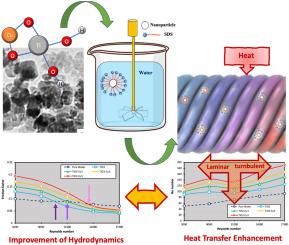利用合成cu掺杂TiO2纳米流体增强螺旋盘管换热器热工性能的实验方法
IF 5
2区 工程技术
Q1 ENGINEERING, MECHANICAL
International Journal of Thermal Sciences
Pub Date : 2025-10-07
DOI:10.1016/j.ijthermalsci.2025.110338
引用次数: 0
摘要
随着全球能源需求的增加、环境问题的关注和传统资源的枯竭,提高热交换器等能源密集型系统的效率已成为当务之急。本研究通过溶胶-凝胶法合成掺杂铜的TiO2纳米颗粒来解决这一挑战,旨在同时提高传热速率和降低泵送功率,从而克服纳米流体应用中流动阻力增加的常见问题,并提高螺旋盘管换热器的热工性能。通过FTIR、XRD、DLS、ICP-OES和TEM分析,制备了Cu掺杂浓度分别为1%、3%和5%的三种Cu掺杂TiO2样品,证实了Cu2+的成功掺杂和分散性的提高。基于原始TiO2和cu掺杂TiO2 (5wt %的去离子水)的纳米流体在水平定向的螺旋铜线圈(内径:9.5 mm)中进行了测试,雷诺数范围为5,000至17,000。Cu掺杂显著改善了对流换热,TiO2-Cu5最大强化率为144.8%,协同换热强化率为56.5%。在低流速下,摩擦力增加,而在高雷诺数下,阻力减少高达24.6%。火用效率也有所提高,TiO2-Cu5达到58%的峰值,达到最高的热水增强系数2.25。这些结果首次证明了cu掺杂TiO2纳米流体可以同时增强热交换器中的传热和流动效率。本研究首次提出了TiO2和cu掺杂TiO2纳米流体在螺旋管内的努塞尔数和摩擦因数的相关性,涵盖了层流和湍流状态。本文章由计算机程序翻译,如有差异,请以英文原文为准。

Enhanced thermohydraulic performance in helical coil heat exchangers using synthesized Cu-doped TiO2 nanofluids: An experimental approach
With increasing global energy demand, environmental concerns, and the depletion of traditional resources, enhancing the efficiency of energy-intensive systems such as heat exchangers has become imperative. This study addresses this challenge by synthesizing copper-doped TiO2 nanoparticles via a sol–gel method, aiming to simultaneously improve heat transfer rates and reduce pumping power—thereby overcoming the common issue of increased flow resistance in nanofluid applications and enhancing thermohydraulic performance in helical coil heat exchangers. Three Cu-doped TiO2 samples were prepared with doping levels of 1 %, 3 %, and 5 % Cu, and characterized using FTIR, XRD, DLS, ICP-OES, and TEM analyses, confirming successful Cu2+ incorporation and improved dispersion stability. Nanofluids based on pristine TiO2 and the Cu-doped TiO2 (5 wt% in deionized water) were tested in a horizontally oriented helical copper coil (inner diameter: 9.5 mm) across a Reynolds number range of 5,000 to 17,000. Cu doping markedly improved convective heat transfer, with TiO2–Cu5 achieving 144.8 % maximum enhancement and a Synergistic Heat Transfer Enhancement of 56.5 %. While friction rose at low flow rates, drag reduction up to 24.6 % occurred at higher Reynolds numbers. Exergy efficiency also increased, peaking at 58 % for TiO2–Cu5, which reached the highest thermal–hydraulic enhancement factor of 2.25. These results demonstrate, for the first time, that Cu-doped TiO2 nanofluids can simultaneously enhance heat transfer and flow efficiency in heat exchangers. This study presents the first correlations for Nusselt number and friction factor of TiO2 and Cu-doped TiO2 nanofluids in a helical tube, covering laminar and turbulent regimes.
求助全文
通过发布文献求助,成功后即可免费获取论文全文。
去求助
来源期刊

International Journal of Thermal Sciences
工程技术-工程:机械
CiteScore
8.10
自引率
11.10%
发文量
531
审稿时长
55 days
期刊介绍:
The International Journal of Thermal Sciences is a journal devoted to the publication of fundamental studies on the physics of transfer processes in general, with an emphasis on thermal aspects and also applied research on various processes, energy systems and the environment. Articles are published in English and French, and are subject to peer review.
The fundamental subjects considered within the scope of the journal are:
* Heat and relevant mass transfer at all scales (nano, micro and macro) and in all types of material (heterogeneous, composites, biological,...) and fluid flow
* Forced, natural or mixed convection in reactive or non-reactive media
* Single or multi–phase fluid flow with or without phase change
* Near–and far–field radiative heat transfer
* Combined modes of heat transfer in complex systems (for example, plasmas, biological, geological,...)
* Multiscale modelling
The applied research topics include:
* Heat exchangers, heat pipes, cooling processes
* Transport phenomena taking place in industrial processes (chemical, food and agricultural, metallurgical, space and aeronautical, automobile industries)
* Nano–and micro–technology for energy, space, biosystems and devices
* Heat transport analysis in advanced systems
* Impact of energy–related processes on environment, and emerging energy systems
The study of thermophysical properties of materials and fluids, thermal measurement techniques, inverse methods, and the developments of experimental methods are within the scope of the International Journal of Thermal Sciences which also covers the modelling, and numerical methods applied to thermal transfer.
 求助内容:
求助内容: 应助结果提醒方式:
应助结果提醒方式:


